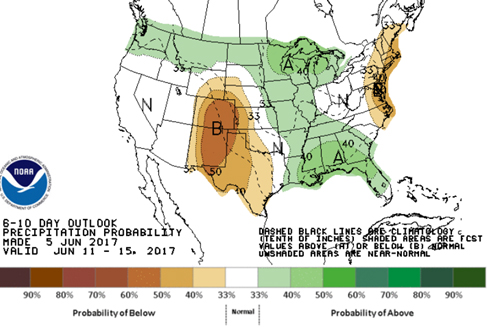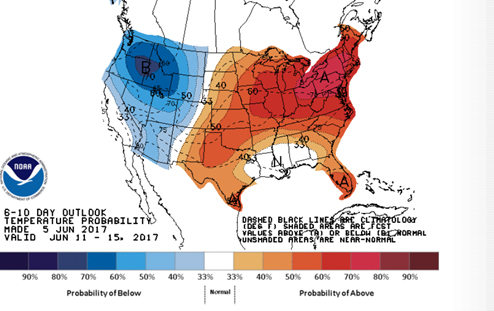USDA trimmed another percentage point from the good/excellent category for winter wheat condition in the 18 states it tracks. It is now pegged at 49 percent. The poor/very poor end of the scale held steady this week at 15 percent. The Kansas crop is rated 26 percent in poor/very poor status, with 43 percent in the top end of the scale.
The 18-state crop progressed to 87 percent headed, 2 points ahead of average. Ten percent of the winter crop has been harvested.
Ninety percent of the spring wheat crop has emerged, 5 points ahead of average. Condition of the spring crop worsened noticeably, with the good/excellent categories slipping from 62 percent to 55 percent and poor/very poor increasing to 11 percent from 6 percent.
Corn Crop Condition Improved
With 86 percent of the corn emerged (against 87 percent average), USDA’s Crop Progress report rated corn condition as of June 4 at 68 percent good/excellent, 3 points better than its first condition report, and 6 percent poor/very poor, a 1 percentage point improvement. This compares with 75 percent on the top end and just 4 percent on the bottom end last year.
Percent of corn in the top and bottom ends of the range in the 18 states accounting for 92 percent of 2016 corn acres
|
Good/excellent |
Poor/very poor |
| USA |
68 |
6 |
| KS |
61 |
9 |
| IA |
77 |
3 |
| NE |
79 |
2 |
| SD |
62 |
6 |
| CO |
89 |
0 |
| IL |
59 |
11 |
| IN |
46 |
17 |
| KY |
82 |
4 |
| MI |
70 |
4 |
| MN |
77 |
2 |
| MO |
59 |
7 |
| NC |
77 |
5 |
| ND |
67 |
7 |
| OH |
49 |
10 |
| PA |
82 |
0 |
| TN |
83 |
3 |
| TX |
79 |
5 |
| WI |
67 |
7 |
Data: USDA/NASS
Soybean status
Soybean planting has reached 83 percent, ahead of its 79 percent average, according to USDA. Indiana, Michigan and Wisconsin continue to lag their averages.
Emergence in the 18 states is at 58 percent, only 1 point behind the five-year average, but states that are behind in planting, such as Ohio, are double-digits behind average for emergence.
Percent planted and emerged in the 18 states accounting for 95 percent of 2016 soybean acres
|
Planted
|
Emerged
|
|
6/4/17 |
5-yr avg |
Difference (percentage points) |
6/4/17 |
5-yr avg |
Difference (percentage points) |
| USA |
83 |
79 |
4 |
58 |
59 |
-1 |
| KS |
59 |
57 |
2 |
39 |
39 |
0 |
| IA |
91 |
84 |
7 |
62 |
65 |
-3 |
| NE |
91 |
90 |
1 |
62 |
67 |
-5 |
| SD |
92 |
83 |
9 |
62 |
55 |
7 |
| AR |
85 |
76 |
9 |
78 |
67 |
12 |
| IL |
85 |
81 |
4 |
62 |
66 |
-4 |
| IN |
75 |
85 |
-10 |
47 |
64 |
-17 |
| KY |
60 |
54 |
6 |
38 |
37 |
1 |
| LA |
96 |
91 |
5 |
93 |
84 |
9 |
| MI |
75 |
85 |
-10 |
46 |
61 |
-15 |
| MN |
94 |
86 |
8 |
68 |
63 |
5 |
| MS |
92 |
88 |
4 |
89 |
78 |
11 |
| MO |
71 |
60 |
11 |
51 |
44 |
7 |
| NC |
57 |
53 |
4 |
42 |
39 |
3 |
| ND |
94 |
81 |
13 |
57 |
50 |
7 |
| OH |
74 |
87 |
-13 |
52 |
62 |
-10 |
| TN |
62 |
60 |
2 |
45 |
41 |
4 |
| WI |
73 |
80 |
-7 |
34 |
53 |
-19 |
Data: USDA/NASS
Grain Sorghum Planting
Grain sorghum in the 11 states USDA reports stands at 55 percent, with Kansas one quarter completed. The average for this time is 60 percent. Kansas is 14 percentage points behind its 39 percent average.
Weather ahead: A mixed bag
The six to 10 day forecast points to slightly better than average probability of above average precipitation through the Midwest, while the Eastern Corn Belt has normal chances. This should allow producers in the states that are lagging their normal soybean planting progress to forge ahead.

At the same time, most of the country east of the Rocky Mountains faces well above probabilities of hotter than normal temperatures.


